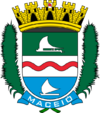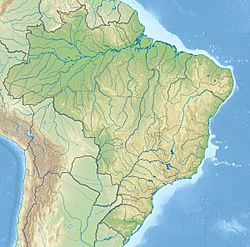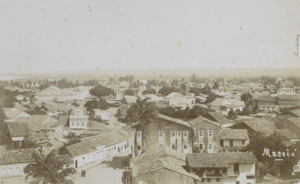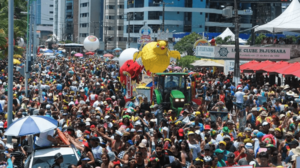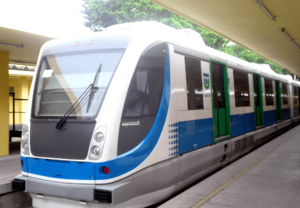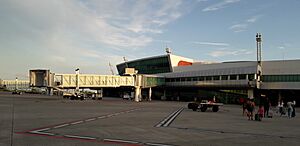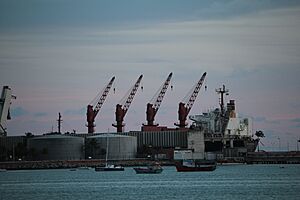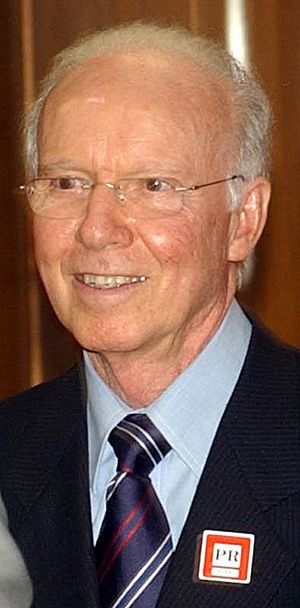Maceió facts for kids
Quick facts for kids
Maceió
|
|||
|---|---|---|---|
|
Municipality
|
|||
| Municipality of Maceió | |||
|
Ipioca beach (left) and Pajuçara beach
|
|||
|
|||
| Nickname(s):
"Brazilian Caribbean"
|
|||
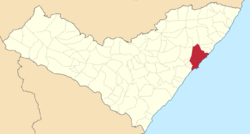
Location of Maceió in the State of Alagoas
|
|||
| Country | |||
| State | |||
| Mesoregion | Leste Alagoano | ||
| Microregion | Maceió, Alagoas, Brasil | ||
| Founded | December 5, 1815 | ||
| Area | |||
| • Total | 511 km2 (197 sq mi) | ||
| Elevation | 7 m (23 ft) | ||
| Population
(2022)
|
|||
| • Total | 957.916 | ||
| • Density | 1,880.77/km2 (4,871.2/sq mi) | ||
| Demonym(s) | Maceioense | ||
| Time zone | UTC−3 (BRT) | ||
| Postal code |
57000-001 a 57099-999
|
||
| Area code | +55 82 | ||
| HDI (2010) | 0.721 – high | ||
Maceió is the capital city of Alagoas, a state in Brazil. It is the largest city in Alagoas. The city's name, "Maceió," comes from an Indigenous word for a spring.
Many of these springs flow into the sea. However, some get trapped and form lakes. Because there are many springs and lakes in this area, the city was named Maceió. The state was named Alagoas, which means "the lakes."
Maceió has a modern airport called Zumbi dos Palmares International Airport. It connects the city to many places in Brazil and other countries. The city is also home to the Federal University of Alagoas.
Contents
- What Does the Name Maceió Mean?
- Maceió's History and Growth
- Maceió's Geography and Climate
- Maceió's Economy and Tourism
- Education in Maceió
- Maceió's Culture and Arts
- Main Sights and Beaches
- Delicious Food in Maceió
- Transportation in Maceió
- Sister Cities of Maceió
- Maceió's Neighborhoods
- Highlights Around Maceió
- Notable People from Maceió
- Images for kids
- See also
What Does the Name Maceió Mean?
The name "Maceió" comes from the Tupi language. It means "what covers the swamp."
A "maceió" can also mean a temporary lake. This lake forms near the sea where a small river meets the ocean. The sand can block the river until the high tide opens the way. This happens at certain times of the year or moon phases.
Maceió's History and Growth
Maceió started as a sugar mill and plantation complex. This was around the 19th century. Its growth began when ships came to collect wood from Jaraguá bay.
As more sugar mills were built, Maceió started exporting sugar. Later, it also exported tobacco, coconuts, leather, and spices. Because it was growing so much, the settlement became a village on December 5, 1815.
Maceió continued to grow and became the capital of the Alagoas state. This happened on December 9, 1839. Its port also developed a lot, helping it change from a small village into a big city.
Maceió's Geography and Climate
Maceió is located between the Mundaú Lagoon and the Atlantic Ocean. It has a tropical climate. The average temperature is about 25°C (77°F). In 2021, the area around Maceió had over 1.3 million people.
Maceió's Tropical Climate
Maceió has a typical tropical climate. This means it has very warm to hot temperatures all year. The air is also very humid. However, strong winds from the ocean help to keep it from getting too hot.
January is usually the warmest month. The highest temperatures are around 32°C (90°F). The lowest are about 22°C (72°F). July is the coolest month. Highs are around 27°C (81°F) and lows are about 17°C (63°F). July also gets more rain.
The natural plants around Maceió are tropical rainforest. These forests get a lot of rain, usually more than 1,700 mm (67 inches) each year. The soil in rainforests can sometimes be poor. This is because heavy rain washes away nutrients.
| Climate data for Maceió (1981–2010, extremes 1961–present) | |||||||||||||
|---|---|---|---|---|---|---|---|---|---|---|---|---|---|
| Month | Jan | Feb | Mar | Apr | May | Jun | Jul | Aug | Sep | Oct | Nov | Dec | Year |
| Record high °C (°F) | 34.8 (94.6) |
34.9 (94.8) |
35.0 (95.0) |
35.3 (95.5) |
36.4 (97.5) |
31.8 (89.2) |
31.1 (88.0) |
31.8 (89.2) |
39.3 (102.7) |
34.6 (94.3) |
38.4 (101.1) |
35.4 (95.7) |
39.3 (102.7) |
| Mean daily maximum °C (°F) | 31.0 (87.8) |
31.4 (88.5) |
31.5 (88.7) |
30.6 (87.1) |
29.5 (85.1) |
28.3 (82.9) |
27.6 (81.7) |
27.6 (81.7) |
28.4 (83.1) |
29.9 (85.8) |
30.8 (87.4) |
31.2 (88.2) |
29.8 (85.6) |
| Daily mean °C (°F) | 26.0 (78.8) |
26.2 (79.2) |
26.5 (79.7) |
26.0 (78.8) |
25.1 (77.2) |
24.1 (75.4) |
23.5 (74.3) |
23.5 (74.3) |
24.1 (75.4) |
25.1 (77.2) |
25.6 (78.1) |
26.0 (78.8) |
25.1 (77.2) |
| Mean daily minimum °C (°F) | 21.4 (70.5) |
21.8 (71.2) |
22.1 (71.8) |
21.8 (71.2) |
21.2 (70.2) |
20.3 (68.5) |
19.7 (67.5) |
19.7 (67.5) |
19.9 (67.8) |
20.3 (68.5) |
20.9 (69.6) |
21.2 (70.2) |
20.9 (69.6) |
| Record low °C (°F) | 17.9 (64.2) |
17.8 (64.0) |
16.4 (61.5) |
13.2 (55.8) |
17.0 (62.6) |
11.3 (52.3) |
15.0 (59.0) |
15.0 (59.0) |
15.8 (60.4) |
17.0 (62.6) |
17.4 (63.3) |
17.9 (64.2) |
11.3 (52.3) |
| Average rainfall mm (inches) | 83.0 (3.27) |
72.9 (2.87) |
117.4 (4.62) |
207.5 (8.17) |
296.9 (11.69) |
353.8 (13.93) |
265.2 (10.44) |
201.5 (7.93) |
120.2 (4.73) |
61.6 (2.43) |
46.9 (1.85) |
40.5 (1.59) |
1,867.4 (73.52) |
| Average rainy days (≥ 1.0 mm) | 9 | 7 | 10 | 16 | 18 | 22 | 23 | 20 | 13 | 7 | 5 | 6 | 156 |
| Average relative humidity (%) | 75.9 | 74.2 | 74.9 | 77.8 | 81.1 | 82.6 | 82.8 | 81.9 | 78.7 | 76.1 | 74.1 | 73.9 | 77.8 |
| Mean monthly sunshine hours | 241.4 | 218.6 | 209.6 | 202.5 | 198.5 | 162.8 | 169.2 | 180.6 | 190.2 | 220.4 | 247.9 | 257.5 | 2,499.2 |
| Source 1: Instituto Nacional de Meteorologia | |||||||||||||
| Source 2: Meteo Climat (record highs and lows) | |||||||||||||
| Climate data for Maceió (1991-2020) | |||||||||||||
|---|---|---|---|---|---|---|---|---|---|---|---|---|---|
| Month | Jan | Feb | Mar | Apr | May | Jun | Jul | Aug | Sep | Oct | Nov | Dec | Year |
| Mean daily maximum °C (°F) | 31.0 (87.8) |
31.3 (88.3) |
31.5 (88.7) |
30.7 (87.3) |
29.5 (85.1) |
28.4 (83.1) |
27.6 (81.7) |
27.8 (82.0) |
28.6 (83.5) |
29.9 (85.8) |
30.8 (87.4) |
31.3 (88.3) |
29.9 (85.8) |
| Average precipitation mm (inches) | 91.2 (3.59) |
80.2 (3.16) |
101.3 (3.99) |
194.3 (7.65) |
294.7 (11.60) |
322.8 (12.71) |
270.9 (10.67) |
191.5 (7.54) |
109.2 (4.30) |
70.2 (2.76) |
45.1 (1.78) |
36.7 (1.44) |
1,808.1 (71.19) |
| Average rainy days | 10 | 11 | 17 | 19 | 22 | 24 | 23 | 19 | 15 | 10 | 6 | 9 | 185 |
| Average relative humidity (%) | 77.1 | 76.0 | — | 78.3 | 81.3 | 83.3 | 84.1 | 82.7 | 80.4 | 77.4 | 75.6 | 75.1 | — |
| Average dew point °C (°F) | 22.2 (72.0) |
22.3 (72.1) |
22.6 (72.7) |
22.6 (72.7) |
22.4 (72.3) |
22.0 (71.6) |
21.5 (70.7) |
21.3 (70.3) |
21.4 (70.5) |
21.6 (70.9) |
21.7 (71.1) |
22.0 (71.6) |
22.0 (71.5) |
| Mean daily sunshine hours | 8.2 | 8.1 | 6.5 | 6.6 | 6.2 | 6 | 5.7 | 6.6 | 6.8 | 8.1 | 9.2 | 8.5 | 7.2 |
| Mean daily daylight hours | 12.6 | 12.4 | 12.1 | 11.9 | 11.7 | 11.6 | 11.6 | 11.8 | 12.1 | 12.3 | 12.6 | 12.7 | 12.1 |
| Average ultraviolet index | 12 | 12 | 12 | 12 | 10 | 9 | 9 | 10 | 12 | 12 | 12 | 12 | 11 |
| Source 1: INMET(Precipitation), (Dew Point), (Humidity) | |||||||||||||
| Source 2: Weather atlas(Sun-daylight-UV-Rainy days) | |||||||||||||
Maceió's Economy and Tourism
Maceió has several important industries. One is based on chemical products. These come from salt water pumped from deep underground. Another big industry is making ethanol and sugar from sugarcane.
In recent years, tourism has grown a lot. The coastal areas of Maceió are now lively places. They attract tourists from Brazil and other countries. These areas have coconut palm trees, playgrounds, and sports fields. You can also find shops, restaurants, hotels, and places for entertainment.
In 2019, the city's total economic output (GDP) was R$23.4 billion. The average income per person was about R$22,976.
Tourism is a very strong part of Maceió's economy. The city has beautiful natural scenery and a rich culture. It offers many fun activities and modern places for business. For example, there is the new Cultural and Exhibition Center. The Zumbi dos Palmares International Airport was opened in 2005. It is one of the most modern airports in Brazil.
The Jaraguá neighborhood is a busy commercial area. It has banks, museums, and colleges.
Education in Maceió
Maceió has many places for higher education. These include several universities and colleges:
- Universidade Federal de Alagoas (UFAL)
- Universidade Estadual de Alagoas (Uneal)
- Universidade de Ciências da Saúde de Alagoas (Uncisal)
- Centro de Ensino Superior de Maceió (CESMAC)
- Centro Universitário Tiradentes (UNIT)
- Faculdade de Alagoas (FAL)
- Instituto Federal de Alagoas (IFAL)
- Faculdade Maurício de Nassau
- Faculdade Pitágoras de Maceió
The city also has top high schools. Some of these are Maria Montessori, Escola SEB, Colégio Santa Úrsula, and Colégio Marista de Maceió.
Maceió's Culture and Arts
You can hear many types of music in Maceió. This includes American jazz and rock. All kinds of Brazilian music and dances are also popular. They are played in bars, restaurants, and at street festivals.
There are movie theaters in several shopping malls. These include Maceió Shopping and Parque Shopping Maceió. Live shows can be seen at the Deodoro Theatre and Gustavo Leite Theatre.
Maceió has several museums to explore:
- Théo Brandão Museum: Shows folk and traditional arts.
- Museum of the Historical and Geographical Institute of Alagoas: Has fine arts and historical items.
- Pierre Chalita Museum: Focuses on fine arts.
- Museum of Image and Music: Features photos, films, and sound recordings.
- Museum of Sport.
- Museum of Natural History UFAL: Used for research by the Federal University of Alagoas.
You can find local folk art at the Théo Brandão Museum. There are also outdoor markets at Pajuçara Beach and Pontal da Barra. The city is also the center of the Roman Catholic Archdiocese of Maceió.
Festa Junina: A Traditional Celebration
Festa Junina is a special celebration in Northeastern Brazil. It was brought by the Portuguese. It celebrates St. John's Day, which is on June 24. In Brazil, these parties happen during the Southern Hemisphere winter.
The festivities start after June 12 and last until June 29. During this time, people light bonfires and set off fireworks. They also do folk dances in the streets. Special foods and drinks are served. People wear peasant costumes, dance, and enjoy the visual shows. Bonfires are a very important part of these celebrations.
Other Cultural Traditions
- Gogó da Ema: This was a famous palm tree that had a crooked trunk. It looked like a letter 'N'. The tree fell in 1955. It became a symbol for Maceió's culture and tourism. There is even a beach named after it.
Main Sights and Beaches
Maceió is famous for its many beautiful beaches. The sea water changes from emerald green to blue. It is always clear. The sand is white, and there are many coconut trees.
The sea near Maceió has natural pools and reefs. These are a few meters from the coast. You can reach them by boat or raft. The Mundaú lake is another place to go sailing and swim in clear water.
Important historical buildings in Maceió include:
- The Cathedral of Our Lady of Pleasures (built in 1840).
- The Deodoro Theatre.
- The Municipal Market.
- The Historical Institute Museum.
- The Floriano Peixoto Palace, which is where the Alagoas State government works.
Delicious Food in Maceió
Maceió's food specialties include fresh fish, shrimp, crabs, and lobsters. These are prepared using local recipes. Some popular dishes are tapioca, acaraje, carne-de-sol, and cuscuz de tapioca. A type of shellfish called sururu is also very popular. It is used in many traditional dishes.
Transportation in Maceió
Public Transportation
Maceió has a Maceió Urban Rail system. This is a light rail system that helps people get around the city.
International Airport
The Zumbi dos Palmares International Airport is located outside Maceió. It has flights to other countries like Lisbon in Portugal and Buenos Aires in Argentina. It also connects to many cities across Brazil. In 2021, over 1.8 million passengers used this airport.
Port of Jaraguá
The Port of Jaraguá is an important port in Maceió. Its growth helped the city of Maceió to develop. The port is in a natural area, which makes it easy for ships to dock. During the Brazilian colonial period, the port exported sugar, tobacco, coconuts, and spices. In 2022, the largest cruise ship to visit the port was the MSC Seashore.
Highways Connecting Maceió
Maceió is connected to other major Brazilian cities by several highways. These include the BR-104, BR-101, BR-316, and AL-101 highways. Here are some distances to other cities:
- Brasília: 2,010 km (1,249 mi)
- Recife: 270 km (168 mi)
- Aracaju: 290 km (180 mi)
- Salvador: 610 km (379 mi)
Sister Cities of Maceió
Maceió has special connections with other cities around the world. These are called "sister cities":
Maceió's Neighborhoods
Maceió has about 50 different neighborhoods. Some of them are:
- Antares
- Barro Duro
- Bebedouro
- Benedito Bentes
- Bom Parto
- Canaã
- Centro de Maceió (Downtown)
- Chã de Bebedouro
- Chã da Jaqueira
- Cidade Universitária
- Clima Bom
- Cruz das Almas
- Farol
- Feitosa
- Fernão Velho
- Garça Torta
- Gruta de Lourdes
- Guaxuma
- Ipioca
- Jacarecica
- Jacintinho
- Jaraguá
- Jardim Petrópolis
- Jatiúca
- Levada
- Mangabeiras
- Mutange
- Ouro Preto
- Pajuçara
- Pescaria
- Pinheiro
- Pitanguinha
- Poço
- Ponta da Terra
- Ponta Grossa
- Ponta Verde
- Pontal da Barra
- Prado
- Petrópolis
- Riacho Doce
- Rio Novo
- Santa Amélia
- Santo Amaro
- Santos Dumont
- São Jorge
- Serraria
- Tabuleiro do Martins
- Trapiche da Barra
- Vergel do Lago.
Highlights Around Maceió
There are many interesting places to visit near Maceió:
- Praia do Francês (French's Beach)
- Barra Nova (New Waterway)
- Dunas de Marapé (Dunes of Marapé)
- Nove Ilhas (Nine Islands)
- Massagüera (or Massagueira)
- Barra de São Miguel (San Miguel Waterway)
- Praia do Gunga (Gunga's Beach)
- Sonho Verde (Green Dream)
- Barra de Santo Antônio (Santo Antonio Waterway)
- Maragogi
- Murici
- Japaratinga
- Pontal do Coruripe
- A Statue of Liberty replica in front of the Museum of Image and Sound of Alagoas.
Notable People from Maceió
Many famous people were born in Maceió:
- Arthur Lira: The current president of the Chamber of Deputies of Brazil.
- Bruna Tenório: A well-known fashion model.
- Bruno de Barros: A Brazilian sprinter and Olympic medalist.
- Maurício Borges: A Brazilian volleyball player and Olympic champion.
- Djavan: A famous singer and musician.
- Fernando Collor de Mello: A former president of Brazil (1990-1992).
- Floriano Peixoto: The second president of the Brazilian republic.
- Graciliano Ramos: A Brazilian writer and journalist.
- Tiago Fernandes: A former Brazilian tennis player. He won the 2010 Australian Open in Boys Singles.
- Zagallo (Mário Jorge Lobo Zagallo): A famous football coach.
- Maria Eduarda Arakaki: Considered one of Brazil's best rhythmic gymnasts ever.
- Yohansson Nascimento: An athlete and Paralympic champion.
- Nise da Silveira: A psychiatrist.
- Képler Laveran Lima Ferreira (known as 'Pepe'): A football player.
- Adriano Gabiru: A football player who won the 2006 FIFA Club World Cup.
- Roberto Firmino: A football player.
- Roberval Davino: A football coach.
- Sandra Suruagy: A volleyball player and Olympic medalist.
- Manuel Deodoro da Fonseca: The first Brazilian President.
Images for kids
See also
 In Spanish: Maceió para niños
In Spanish: Maceió para niños





